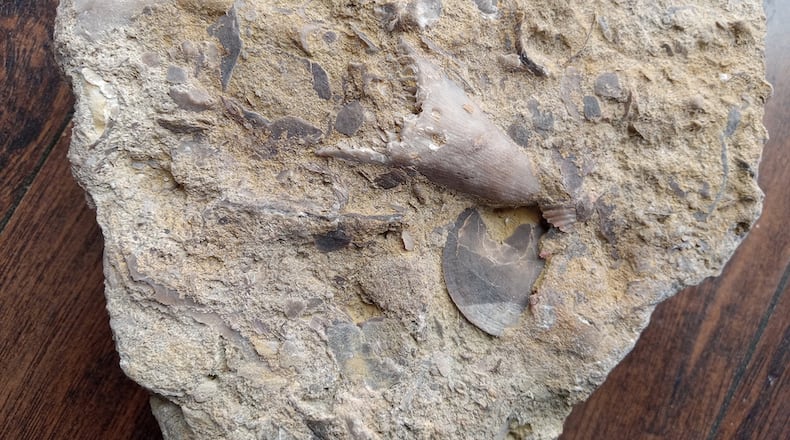How it all started
Millions of years ago (at least 425 million years ago), Ohio was covered by a warm-water sea. When some of the sea creatures perished, their remains or impressions of those with hard bones or shells were sometimes preserved in the sediment. Layers and layers of debris and other materials followed, and over the centuries, formed into rock and fossils.
The sea waters are no longer here, but the rocks and their encapsulated creatures remain under the layers, deep underground, until something removes the layers to reveal them. Typically, water is involved.
Where to find them
Streams are continuously cutting through the ground and rock, revealing the past one layer at a time. That makes streams and creeks a great place to look for fossils. New areas are always being exposed. In shallow water, it can be as easy as walking the stream bed.
But it takes a long time to displace even a few feet of ground naturally down to the layers where fossils reside. That is, unless a big digging project happens.
The creation of dams and spillways in the area has cut right to the point where fossils appear. That means no waiting and no digging for local fossil hunters. The emergency spillway for Caesars Creek Dam has become widely recognized as a great place to look for fossils.
Likewise, several locations within the Five Rivers Metro Park offer opportunities to search for and find fossils. These include below the Germantown Dam at Germantown MetroPark, below Englewood Dam at Englewood MetroPark, and among the stepping stones in Sugar Creek within Sugar Creek MetroPark.
What you might find
The now-gone sea was teaming with life, but only a select few animals had the characteristics that enabled them to become fossilized. The fossils found in Southwest Ohio are from the Ordovician Period (450 million years ago) and the Silurian Period (425 million years ago).
Most of them are invertebrates, meaning they didn’t have backbones (aka, a spine). Vertebrates were just coming on the scene then, so it’s possible that a fossilized fish might be found. The Five Rivers MetroPark offers a brochure and checklist for what you might find. Some species include:
- Trilobites - Ohio’s state fossil, and relative of modern crabs and spiders
- Cephalopods - predecessors of today’s octopus and squids
- Gastropods - ancient versions of snails
- Crinoids - often called sea lilies, but were actually animals
- Horned Coral - solitary versions of the coral we see now in colonies
- Bryozoans - tiny creatures that numbered in the thousands
- Brachiopods - one of the most common fossils found in the area, and still present today
If you’re interested in picking up some real skeletons this October, you won’t have to go far, you don’t have to wait until trick-or-treat, and it won’t cost you a dime (unlike those gigantic bones on your neighbor’s lawn). If you choose to go fossil hunting in the Five Rivers MetroPark, there are specific locations and regulations. Check the website and follow their guidelines: metroparks.org/policies/#fossil-collecting-policy.
If you’re not quite sure how to get started or want to go with someone who knows what they’re doing, the Ohio Department of Natural Resources is offering a free guided trip at Ceasars Creek on Oct. 12th. It will include both a palentologist and geologist on hand to share insights and facts about the history of the area. More information here: ohiodnr.gov/home/news-and-events/all-events/geology-events/guided-fossil-collecting-caesar-creek-ESW2025
Fall is the best. There are tons of activities of all kinds in the area, especially put on by the ODNR. Be sure to check them out.
Devin Meister is a local outdoors and wildlife enthusiast and has a blog called “Average Guy Outdoors.” He is an Ohio University graduate. Reach him at meister.devin@gmail.com.
About the Author


